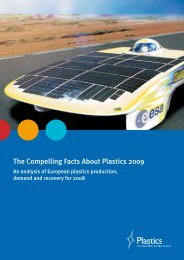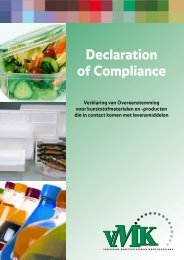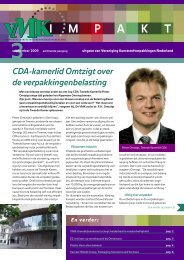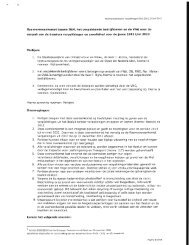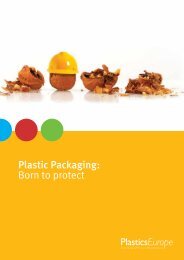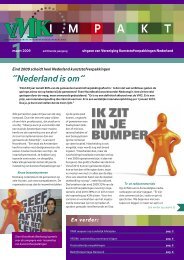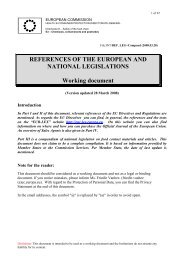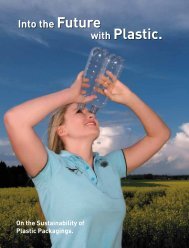food contact materials - European Commission - Europa
food contact materials - European Commission - Europa
food contact materials - European Commission - Europa
- No tags were found...
You also want an ePaper? Increase the reach of your titles
YUMPU automatically turns print PDFs into web optimized ePapers that Google loves.
ANNEX IIPart A: General specificationsPlastic material and articles shall not release primary aromatic amines in a detectable quantity (DL = 0,01 mg/kgof <strong>food</strong> or <strong>food</strong> simulant). The migration of the primary aromatic amines appearing in the list in Annex I of thisdocument is excluded from this restriction.’PART B: Other SpecificationsOTHER SPECIFICATIONSRef. No11530 Acrylic acid, 2-hydroxypropyl ester.It may contain up to 25% (m/m) of acrylic acid, 2-hydroxyisopropyl ester (CAS N. 002918-23-2)16690 DivinylbenzeneIt may contain up to 45% of Ethylvinylbenzene.18888 3-Hydroxybutanoic acid-3-hydroxypentanoic acid, copolymerDefinitionThe copolymers are produced by the controlled fermentation of Alcaligenes eutrophus usingmixtures of glucose and propanoic acid as carbon sources. The organism used has not beengenetically engineered and has been derived from a single wild-type organism Alcaligeneseutrophus strain HI6 NCIMB 10442. Master stocks of the organism are stored as freezedriedampoules. A submaster/working stock is prepared from the master stock and stored inliquid nitrogen and used to prepare inocula for the fermenter. Fermenter samples will beexamined daily both microscopically and for any changes in colonial morphology on avariety of agars at different temperatures. The copolymers are isolated from heat treatmentbacteria by controlled digestion of the other cellular components, washing and drying. Thesecopolymers are normally offered as formulated, melt formed granules containing additivessuch as nucleating agents, plasticisers, fillers, stabilisers and pigments which all conform tothe general and individual specifications.Chemical name Poly(3-D-hydroxybutanoate-co-3-D-hydroxypentanoate)CAS number 080181-31-3Structural formula CH 3|CH 3 O CH 2 O| || | ||(-O-CH-CH 2 -C-)m - (O-CH-CH 2 -C-)nwhere n/(m+n) greater than 0 and less or equal to 0.25Average molecular Not less than 150 000 Daltons (measured by gel permeation chromotography).weightAssayNot less than 98% poly(3-D-hydroxybutanoate-co-3-D-hydoxypentanoate) analysed afterhydrolysis as a mixture of 3-D-hydroxybutanoic and 3-D-hydroxypentanoic acids.DescriptionWhite to off-white powder after isolationCharacteristicsIdentification tests:SolubilitySoluble in chlorinated hydrocarbons such as chloroform or dichloromethane but practicallyinsoluble in ethanol, aliphatic alkanes and water.MigrationThe migration of crotonic acid should not exceed 0.05 mg/kg <strong>food</strong>.RestrictionQMA for crotonic acid is 0.05 mg/6 dm²PurityPrior to granulation the raw material copolymer powder must contain:-Nitrogen-Zinc-Copper-Lead-Arsenic-ChromiumNot more than 2500 mg/kg of plasticNot more than 100 mg/kg of plasticNot more than 5 mg/kg of plasticNot more than 2 mg/kg of plasticNot more than 1 mg/kg of plasticNot more than 1 mg/kg of plastic23547 Polydimethylsiloxane (Mw>6800)Minimum viscosity 100 x 10 -6 m 2 /s (=100 centistokes) at 25 o C24903 Syrups, hydrolysed starch, hydrogenatedIn compliance with the purity criteria for maltitol syrup E 965(ii) (<strong>Commission</strong> Directive 95/31/EC of 5 July 1995(O.J. L 178, 28.7.1995, p.1 as last amended by 2004/46/EC of 16 April 2004 (O.J. L 114, 21.04.2004, p.15 )25385 Triallylamine40 mg/kg hydrogel at a ratio of 1kg <strong>food</strong> to a maximum of 1.5 grams of hydrogel. For use only in hydrogels intendedfor non-direct <strong>food</strong> <strong>contact</strong> use.38320 4-(2-Benzoxazolyl)-4’-(5-methyl-2-benzoxazolyl) stilbeneNot more than 0.05%w/w (quantity of substance used/quantity of the formulation)34 of 41



